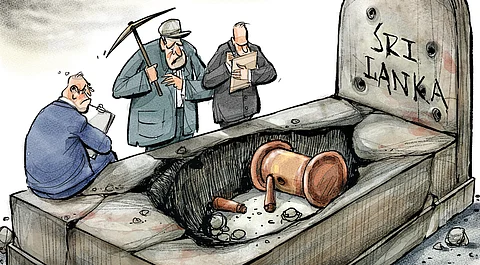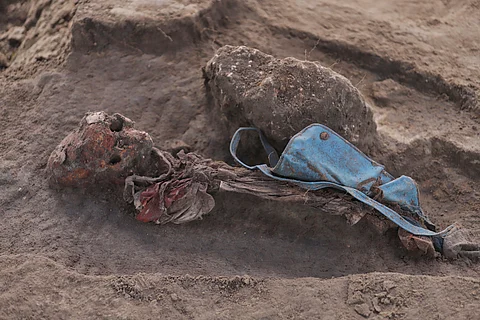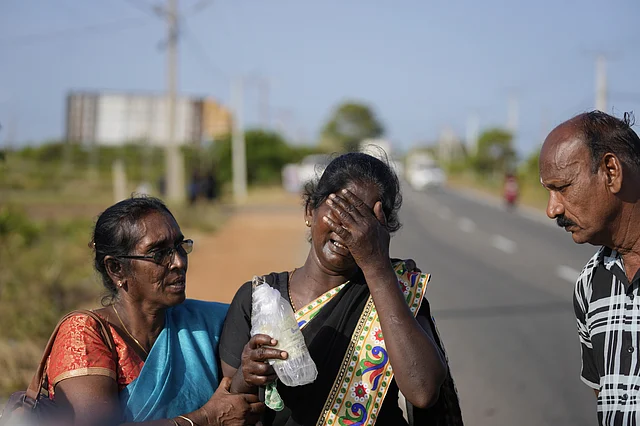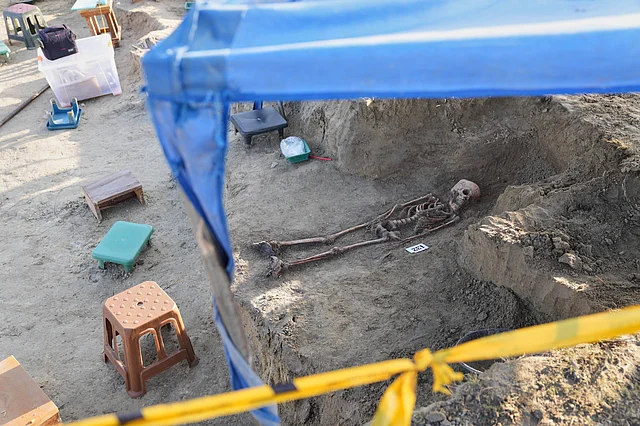
Sourav Roy
The world watches Sri Lanka with keen eyes as evidence of a mass grave re-emerges from Chemmani, in the Tamil heartland of Jaffna. It has refused to stay buried, a quarter century later. Chemmani is among the known mass graves, and a 26-year-long war is most likely to have birthed other sites, still unknown and unidentified. Bearing war’s painful legacy, these mass graves quietly hold the evidence of people killed and buried during years of conflict, a stark reminder of an island’s gruesome past, human rights violations and the absence of justice and accountability.
In February 2025, construction workers unearthed human remains while clearing a land adjacent to the Chemmani-Sindupathi Hindu burial ground. Following a police referral, the Jaffna Magistrate Court initiated a preliminary investigation on February 20 and ordered exhumation and excavation of the remains. On June 2, an expert team led by Prof Raj Somadeva, a top forensic archaeologist, unearthed 19 skeletal remains. As of July 5, ongoing excavations have recovered 45 skeletons, including those of children, all temporarily stored at the University of Jaffna.
Like most mass graves, until 1998, Chemmani was unknown to the world and was shrouded in mystery. It was first mentioned by Lance Corporal Somaratne Rajapakse, one of those accused for the rape and murder of an 18-year-old Tamil school girl, Krishanthi Kumaraswamy. The court served the death sentence on Rajapakse and five other soldiers directly involved in the case as well as the killing of three others. Testifying before the court, Rajapakse said hundreds of people who disappeared from the Jaffna peninsula after the military seized control during 1995-1996 were killed and buried in mass graves near Chemmani. Excavations in 1999 found 15 bodies, including two identified as men who had disappeared in 1996.Present-day excavations continue to unearth skeletal remains and reopen old wounds, renewing calls for international oversight into Sri Lanka’s existing mass graves.
Beyond Chemmani lies more shame, for Sri Lanka has witnessed waves of disappearances with mass graves silently screaming for justice and accountability. Closer to Chemmani lies the Alfred Duraiappa Stadium mass grave, discovered during renovations in 1999. Others include the Kokkuthoduvai and Mulllaitivu mass graves in the North. The Mannar grave was uncovered in 2013. Several graveyards were subsequently discovered in the area, and 346 skeletons have been unearthed so far. There has been controversy surrounding carbon dating, but forensic archaeologists conclude that the discrepancies fall within 30 years and are linked to wartime events.
There are other sites on the island. Discovered in 1994, the Sooriyakanda mass burial ground reportedly contains bodies of around 300 school children from the Embilipitiya High School in Ratnapura, killed in counterinsurgency measures during the 1988-1990 uprising of the Janatha Vimukthi Peramuna (JVP), the main constituent of the current government. Following a UN request, the government excavated the area in September 1994 under court supervision and discovered an unspecified number of skeletons. Linked to those measures is the mass grave in Matale, in central Sri Lanka. Experts have concluded that it was not a typical burial site and confirmed that the remains dated back to the specified period.
There is reason to believe that more unidentified sites exist. However, for successive governments, it has been a case of deep reluctance to deal with their accountability failures. Public agitations and human rights lobbying have intensified, drawing international attention to Sri Lanka’s human rights cover-ups.
In 2021, the UN High Commissioner for Human Rights highlighted political obstruction of accountability for crimes and human rights violations. “Numerous commissions of inquiry appointed by successive governments failed to credibly establish the truth and ensure accountability.” Its 2024 report, “Accountability for Enforced Disappearances in Sri Lanka”, highlighted presidential commissions of inquiry establishing the involvement of the State’s security and paramilitary groups with “elected officials living in denial about the scale and responsibility for such violations”.
They highlighted a failed criminal justice system and a legacy of failed commissions, emboldening the call for international mechanisms.
The Presidential Commission of Inquiry appointed to Investigate and Inquire into Alleged Serious Violations of Human Rights arising since August 1, 2005 (Udalagama Commission) was established in 2006. The 2010 Lessons Learnt and Reconciliation Commission (LLRC) released its report in 2011, and the Presidential Commission of Inquiry into Complaints of Abductions and Disappearances (Paranagama Commission) was set up in 2013. In 2021, a new three-member Commission of Inquiry examined the findings of previous domestic inquiries. Recommendations sent to President Ranil Wickremesinghe in 2023 remain undisclosed. Much hope rides on the Anura Dissanayake presidency to deliver justice and accountability. Tamils overwhelmingly contributed to the NPP’s November landslide, trusting the government to introduce confidence-building measures.
It is not about responding to international pressure. Truth, justice, and non-recurrence are Sri Lanka’s domestic and international human rights obligations towards its people. It should form a part of the NPP’s promised new political culture.
Dilrukshi Handunnetti | Award-winning journalist and lawyer; founder and director of the Colombo-based Center for Investigative Reporting
(Views are personal)
(dilrukshihandunnetti@gmail)
A wartime mass grave in Sri Lanka yields a baby bottle, children’s clothes and 141 skeletons

An exhumed human skeleton is seen with a school bag at the site of a mass grave in Chemmani, Sri Lanka, June 28, 2025.(Photo | AP)
The findings were made at a cremation ground in the Chemmani area near Jaffna town, the cultural heartland of the country’s ethnic Tamil minority. But hardly any burials take place here, as Hindus mostly cremate their dead according to religious customs.
Excavations have been underway since June, after workers found human remains while digging to build an electric crematorium.
A pit test over nine days discovered 19 sets of human remains. Shallow burials of about 1.5 meters (4.9 feet) in a scattered and disorganized manner, and the absence of clothing, indicated the site was a mass grave, according to a report provided to a court in June.
Since the area was secured and declared a crime scene that month, a total of 141 skeletons have been discovered within a 165-square-meter (1,776-square-foot) area. About 135 of the bodies had no clothing, and only one set of adult clothing was identified. Tests confirmed that a skeleton found with a schoolbag was that of a girl between 4 and 6 years old. Toddlers’ dresses, socks and footwear, tiny bead bangles and a baby powder tray were also recovered.
The identities of the dead and the cause and timing of their deaths are all unclear. But many think the victims could be civilians who disappeared during Sri Lanka’s civil war, which broke out in 1983 between government forces and ethnic Tamil rebels, who fought to create an independent homeland for the minority group. The war ended in 2009.
Several Tamil armed groups and an Indian peacekeeping mission were active in the region over the decades. But attention has focused on the Sri Lankan military, which had a heavy presence for over a decade in Chemmani, as the gateway to Jaffna town.
A confession made by an army soldier before he was sentenced to death for rape and murder 27 years ago has strengthened suspicions about the site.
In 1998, Somaratne Rajapakse along with four alleged accomplices from the military and police were sentenced to death for the gang rape and murder of a schoolgirl and the killing of her mother, brother and a neighbor.
The five, who weren’t hanged and remain in prison due to a moratorium on executions, have maintained that they were not involved in the rape and murder, but only disposed of the bodies under orders.
Rajapakse told the court that he knew where up to 400 bodies were buried in Chammani.
“We cannot say exactly who the perpetrators are yet, but the finger points to the (state) army,” said Brito Fernando, an activist working with the families of people who disappeared during various armed conflicts in Sri Lanka.
The area, including the cremation ground, were under Sri Lankan military control from 1996, when it captured Jaffna from the rebels, until after the war ended in 2009. The military operated checkpoints, and anyone who entered or left the area was searched.
In 1999, Rajapakse led police to a spot where the schoolgirl, her family and the neighbor were buried and later showed police other places where more remains were found. But the investigations were abruptly stopped.
Families want closure
Items found at the site were publicly displayed earlier this month in the hope that their owners would be identified, and many people from surrounding villages and beyond visited the site.
Amalanathan Mary Calista, whose husband has been missing since 1996 when the military arrested him in their village, said she hoped seeing proof that her husband was dead would bring a sense of closure.
“I went there hoping to see at least his clothes. There was a sarong (clothing that wraps around the waist) but it wasn’t my husband’s. He was wearing a blue sarong at the time. It was disappointing,” she said.
“I only saw the clothing of little children,” she added, as she wept.
She said her husband is among 24 people who never returned home after the military searched their village. Families had tried to block the army vehicles from taking away the detained people, but the authorities pushed them aside with guns and the vehicles sped away, she said.
“My wish is that he should be alive and return, but we can do nothing if it is not so,” she said.
“The state army arrested him. They must say that they arrested him and that he died at their hands. They also must pay us compensation,” she said.

Senthilvel Sothiladchumi, an ethnic Sri Lankan Tamil, center, whose son went missing during the Sri Lankan civil war, cries as she leaves the site of a mass grave where authorities exhibited unearthed belongings in an effort to secure the identities of the victims, in Chemmani, Sri Lanka, Aug. 5, 2025.(Photo | AP)
Woman recalls military taking her brother and husband away
Sivanathan Selvamalar said she watched her younger brother being loaded into a military truck blindfolded during that same raid. Years later, in 2009, her husband was also detained at a checkpoint. He called her to tell her of his arrest and was not heard from again.
“We went to see the things, thinking they may have buried people who were arrested around this area, but we saw only the things of little children,” she said.
“We have checked all the prisons but have not found them. When we are told that more than 100 skeletons have been dug out, we fear the worst,” she added.
A 2003 report by Sri Lanka’s Human Rights Commission said it investigated 281 complaints of missing persons from 1990 to 1998. Of these, three were found in prisons and later released, while the rest are still unaccounted for. The report said the military was responsible for 243 cases, while the Tamil Tiger rebels were responsible for 25. The responsibility for 10 others is unknown.
No children were listed as missing.
Nadesapillai Vithyatharan, the editor of the only newspaper in the region at the time, said several families returned to Jaffna after fleeing into rebel-held territory as the military moved in. Some reportedly went missing after being stopped at checkpoints set up to look for infiltrating rebels, he said.
Calls for DNA analysis
Although previous investigations stalled, there is hope now that victims will be identified, Fernando said. But he said the government must do more to conduct a credible investigation.
“We don’t have proper guidelines to investigate the mass graves and have no DNA bank to help with identification,” said Fernando, adding that the government should fund a DNA bank and enlist international support in the identification of victims.
“Only a proper investigation by the government can free its military from suspicion,” he said.
Any direct probe into the military would likely anger Sri Lankan nationalists. Many of the majority ethnic Sinhalese admire the military for winning the civil war.

A number identifies a human skeleton exhumed from a mass grave in Chemmani, Sri Lanka, Aug. 5, 2025.(Photo | AP)
Excavations will continue for 8 more weeks
Ground-penetrating radar in other parts of the cremation ground has shown “soil anomalies … that are indicative of comparable density of buried skeletal remains,” according to a report submitted in the Jaffna court last week.
The scanned area is three times larger than the site that has been excavated, said Ranitha Gnanarajah, a lawyer monitoring the process. Investigators have requested court approval to continue excavations for eight more weeks, she said.
Army spokesman Brig. Waruna Gamage said no one has formally accused the army of responsibility for the mass grave, and if they did they would need to show proof, he said.
“The excavations are still ongoing and it is a civil matter belonging to the police and courts,” Gamage said. “We will respect the law of the country.”
Government forces and the rebels are both accused of committing atrocities amounting to war crimes in the months leading to the end of the civil war in 2009.